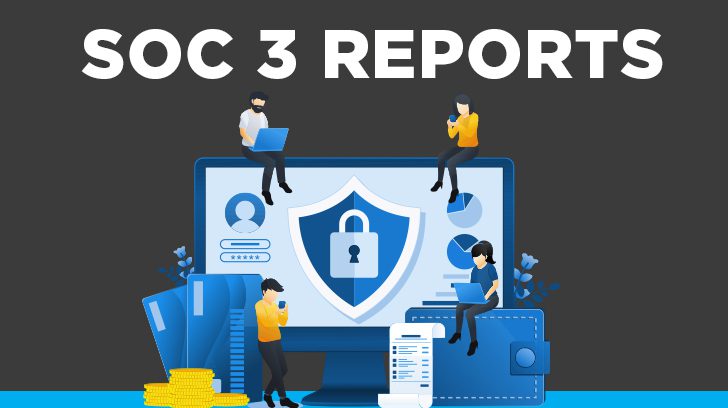System and Organization Control (SOC) audits and reports include SOC 1 (formerly SSAE 16), SOC 2, and SOC 3—which can all be rather confusing. Out of the three SOC reports, a very small percentage are SOC 3s. So, when does it make sense to get a SOC 3?
To understand what a SOC 3 is and whether you need one, it helps to know the difference in the SOC reports. In a nutshell, a SOC 1 audit tests controls meeting the identified objectives for IT, business processes, and key objectives for the services provided with a focus on financial statement impact. SOC 2 audits, however, identify and test only against the criteria as defined in the AICPA Trust Services Criteria.
The differences between SOC 1 and SOC 2 extend beyond this, but both are tested to ensure that the needs of a broad range of users are satisfied. SOC 3 reports, on the other hand, are considered general-use reports and are typically designed as a marketing tool provided to prospective customers who do not need to know the level of information provided in the SOC 2 report.
What is the Difference Between a SOC 2 & SOC 3 Report?
A SOC 3 report is similar to a SOC 2 report and can cover any of the Trust Services Criteria (also referred to as Principles or TSCs). Unlike SOC 2, a SOC 3 report can be freely distributed, including being posted on a company’s website. A SOC 3 report does not contain a detailed description of the service auditor’s tests of controls, results of testing, or the auditor’s opinion on the description of the service organization’s system. The lack of a detailed report requires that a SOC 3 be performed as a Type II, unlike SOC 1 and SOC 2, where there is a Type I option.
SysTrust & SOC 3 SysTrust for Service Organization Seals
In the past, service organizations receiving a SOC 3 were required to pay for a SOC 3 SysTrust service organization seal. However, on October 2, 2014, the AICPA and CPA Canada discontinued the seal program. The cessation of the seal program had no impact on the performance of Trust Services/SOC 3 engagements or the issuance of Trust Services/SOC 3 reports, and service organizations looking to market their SOC 3 engagements should use the AICPA SOC logo.

Do You Need a SOC 3 Report?
Subservice organizations trying to gain additional business or make their services better known may wish to go through a SOC 3 audit and obtain a SOC 3 report to be used as a marketing tool.
SOC 3 reports are a great marketing solution that demonstrates to current and prospective customers that a service organization has the appropriate controls to mitigate risks related to the security, availability, processing integrity, confidentiality, and privacy of customer information being processed. Note, as with a SOC 2 report, the criteria covered in the SOC 3 report are based upon the needs of the service organization with the security criteria being the base of the criteria covered.
What Are the Key Features & Content Included in the SOC 3 Report?
A SOC 3 report contains two key components:
- An independent service auditor’s report on whether management’s assertion is fairly stated, based on the AICPA Trust Services Principles and Criteria for Security, Availability, Processing Integrity, Confidentiality, and Privacy.
- A written assertion by the management of the service organization:
- Stating whether the controls covered under the report were effective throughout the specified period to “provide reasonable assurance that the service organization’s service commitments and system requirements were achieved based on the applicable trust service criteria.” (Per AICPA SOC 2 reporting guidance)
- Describing the system boundaries and the organization’s principal service commitments and system requirements.
What is not included in a SOC 3 report that is in a SOC 2 report is the description of the processes in scope, controls relating to the defined processes, and tests of the defined controls. This limit on information provided in the SOC 3 report is what makes it generic enough to be available for general use.
SOC 3 Compliance
Why is SOC 3 compliance important? Although the SOC 3 is a Type II report and does not contain the summary of the auditor’s control testing results, it includes the results of the tests against the identified TSC. This assures customers that systems at a service organization are protected, for example, against unauthorized access and other risks that could impact the service organization’s ability to provide the services promised to clients.
Given the disastrous consequences of a security breach, such an assurance can go a long way toward securing customer trust.
A SOC 3 report may also include the Availability, Processing Integrity, Confidentiality, and Privacy TSCs, at the discretion of the service organization’s management. These assure customers that concerns such as the following have been addressed:
- The service organization’s systems are available at all times.
- System processing is occurring accurately and timely.
- Data classified as confidential is protected.
- Personal information is protected and handled appropriately.
As a marketing tool to retain existing customers and attract new ones, the ability to prove that a certified auditor independent of the organization agrees with the company’s claims is a powerful instrument.

SOC 3 Audit Process
The SOC 3 audit resembles a SOC 2 audit in many aspects. The difference is in the report generated at the conclusion of the audit process. It covers a range of 6-12 months and begins with detailed conversations between our auditors and the service organization’s management, regarding which TSC meets their unique needs.
Once we understand the TSC requirements, we provide an accurate engagement fee estimate and timeline as well as a to-do list and risk and controls matrix (RCM) to expedite the auditing process. We make every effort to meet all reporting deadlines.
Onsite and/or virtual interviews and examinations are made, with the least disruption possible to the organization’s productivity and daily operations. Once the thorough examination is complete, auditors create a polished SOC 3 report of their audit results. This is delivered digitally to expedite the process of sharing the report.
Secure Your SOC 3 Report
Linford & Co is an independent auditing firm that specializes in SOC audits, as well as a variety of additional audit services, compliance assessments, and more. If your organization would like to harness the power of a SOC 3 report, contact us to discuss your needs today.
This article was originally published on 6/2/2015 and was updated on 5/21/24.

Lois started with Linford & Co., LLP in 2020. She began her career in 1990 and has spent her career working in public accounting at Ernst & Young and in the industry focusing on SOC 1 and SOC 2 and other audit activities, ethics & compliance, governance, and privacy. At Linford, Lois specializes in SOC 1, SOC 2, HIPAA, ISO, and CMMC audits. Lois’ goal is to collaboratively serve her clients to provide a valuable and accurate product that meets the needs of her clients and their customers all while adhering to professional standards.




